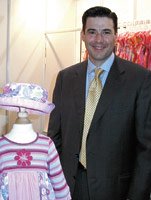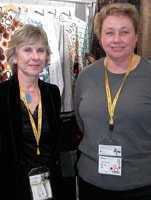Hong Kong Fashion Week
HONG KONG—Leland Smith, a Los Angeles businessman whose childrenswear company is on the move lately, was a bit of an oddity at the recent Hong Kong Fashion Week for Fall/Winter 2004, held Jan. 13–16 at the Hong Kong Convention & Exposition Centre in Hong Kong.
He was the only American clothing manufacturer among a sea of 983 exhibitors to have a booth at the mega event, which attracts thousands of international buyers every year.
Smith and his wife, designer Erin Murphy, launched their now $10 million company, Baby Lulu Inc., in 1992 out of a downtown Los Angeles artist’s loft. They had one goal: Stay in business.
These days, going global is one formula for success, and Hong Kong Fashion Week seemed the perfect place for Smith to seek new retail markets, make some private-label deals and find venues to sell his overruns before they were imported into the U.S. market.
So Smith flew in from Los Angeles, set up his booth and waited for buyers to walk by the pint-sized mannequins sporting floral dresses with matching hats.
“The No. 1 reason we’re here is that we do better childrenswear goods. Because of that, our volume is never going to be exciting [if we stick to the U.S. market],” said the executive, whose company, now based in Commerce, Calif., sells primarily to specialty stores in the United States and Canada and upscale department stores such as Nordstrom and Saks Fifth Avenue.
“I am trying to sell to Japan, Australia or Brazil, where I can ship from Hong Kong to a country where it can go quota-free or dutyfree,” he said, noting that half his garments are made in the United States and the other half are made in Hong Kong and China.
Smith’s trip was fairly successful. The onetime stockbroker met with some Australian distributors interested in the European styling Baby Lulu offered. Smith also conferred with some Chinese distributors regarding a secondary label he would produce.
East meets West
This pairing between Western designers and Eastern customers is just what Hong Kong government officials are trying to nurture as the region competes with the awakening industrial giant called mainland China, where Shanghai is being molded into Asia’s next fashion capital.
Hong Kong officials are optimistic that China holds a golden opportunity for enterprising apparel designers, who can tap into the burgeoning market brimming with fashion-hungry consumers.
And Hong Kong officials feel the region has the perfect ingredient to make that happen. Beginning this year, a free-trade agreement between Hong Kong and mainland China went into effect. The Closer Economic Partnership Arrangement (CEPA) imposes no tariffs on about 90 percent of Hong Kong exports. This includes 37 apparel categories, which in the past had been subjected to duties ranging from 10 percent to 12 percent for fabrics and 14 percent to 20 percent for apparel.
Foreign companies can partner with Hong Kong companies or outsource to Hong Kong manufacturers and businesses to qualify for CEPA tariff advantages. The CEPA benefits are better than those the World Trade Organization gives to its members, who still have to pay tariffs on some goods.
CEPA also permits Hong Kong businesspeople to open small retail stores in China for the first time.
On the flip side, CEPA benefits Hong Kong retailers by allowing more Chinese tourists to visit Hong Kong on their own without signing up for organized tours. According to statistics from French bank Creacute;dit Lyonnais, the average Chinese tourist visiting Hong Kong spends $620 per visit. Last October, 879,000 Chinese tourists visited Hong Kong. Chinese tourists have replaced Japanese tourists in snapping up Louis Vuitton goods in Hong Kong, said Pansy Yau, assistant chief economist with the Hong Kong Trade Development Council, which organizes Hong Kong Fashion Week.
“With the full implementation of CEPA, new opportunities have been brought for development in Hong Kong,” said Patrick Ho, Hong Kong’s secretary for home affairs, who was at the show’s opening ceremony.
The Hong Kong Trade Development Council conducted several surveys to find out what type of apparel might inspire mainland Chinese consumers to dig deeper into their pockets.
“We are quite positive that consumers in China are willing to accept high-end brands,” Yau said. “According to our survey, we found that the middle class is very brand-conscious because that can bring them some status and make them stand out from the crowd.”
Sixty percent of Chinese consumers surveyed said they would pay a premium price for a brand, and 77 percent said they would pay more for a good design.
FBI on the prowl
With that in mind, representatives from Fashion Business Inc., a Los Angeles nonprofit organization that helps small and midsize designers get their businesses off the ground, signed up for World Boutique. The separate show within Hong Kong Fashion Week is geared toward seeking new markets for upscale international designers and brands.
Frances Harder, FBI’s founder and president, and her executive assistant, Carrie Shay, showcased Los Angeles design companies such as Porky Pies, a childrenswear manufacturer; Avita and Alexandra, two contemporary clothing companies; and Couture, The Clothing Co., a collection of men’s and women’s apparel.
At the show, FBI looked for international retailers for Los Angeles labels, as well as opportunities for sourcing and exporting to China. “We’re trying to partner manufacturers in China with brands in L.A. to invest in designers and take a stake in their companies,” Harder said.
Next year, FBI might help launch a California pavilion at the World Boutique to showcase the contemporary, casual and fashion-forward styles that California is known for, incorporating plenty of boardsports and activewear apparel from Los Angeles and Orange counties.
Year of the monkey
Hong Kong Fashion Week for Fall/Winter 2004 opened with 7 percent more exhibitors than the January 2003 show. Some 983 companies from mostly mainland China and Hong Kong staffed booths in three enormous exhibit halls. There were 19 fashion shows.
At the World Boutique, now in its second year, some 190 international companies participated, slightly more than the 178 that signed up in January 2003.
Despite the increase in exhibitors, attendance at the four-day event was down 15 percent, with 20,102 people passing through the exhibit halls this year, compared with 23,706 a year earlier.
“We think that the beginning of the Chinese New Year being so close to Hong Kong Fashion Week contributed to the drop because many international buyers could not find seats on international flights that were full with people coming to China for the new year,” said Benjamin Chau, director of exhibitions for the Hong Kong Trade Development Council. During the trade show’s run, many in Hong Kong prepared to ring in the year of the monkey. The Chinese New Year began Jan. 22, 10 days after the fair’s launch.
Hong Kong residents made up slightly more than half the attendees, followed by mainland China, Japan, the United States, Taiwan and Australia.
Many exhibitors noticed the drop in visitors.
“The old customers are coming here, but we haven’t seen any new customers,” said Donna Wong of Hong Kong–based Eve Fashion Wholesales Co. Ltd., which makes women’s apparel and handbags.
“There aren’t as many buyers as last year,” said Elaine Chan, assistant merchandise manager at Sureway Garment Ltd., a womenswear manufacturer based in Hong Kong.
The buzz among exhibitors this year was the belief that U.S. quotas for Chinese goods would not be completely eliminated in 2005.
“I think there is going to be some self-control imposed on China by the United States,” said Hilary Tang, owner of Joyful Day Ltd., a Hong Kong company with a factory in China. Tang, a first-time attendee of Hong Kong Fashion Week, said he is trying to get more international buyers for his collection of ladies’ jackets, sweaters, slacks and denim pants.
Manufacturers also talked about a growing price war. Many manufacturers said they were reducing their price points by 5 percent to 10 percent to win business from buyers.
“We have lowered our prices 5 percent over last year because there are too many competitors,” said Lambert Lam, division manager for Hong Kong–based Real Concept International Ltd., a manufacturer of men’s and women’s casualwear and denim.
However, lower prices helped many to stay on top and corral more orders.
“I’m very happy,” Lam said, noting that he had not done that well at the January 2003 show. “Our orders are up 30 percent.”
Others had a harder time writing orders.
“It has been more or less a mixed response,” observed Prashant Ramola, general manager of merchandising at Jain International, an Indian company that makes beaded and sequined evening gowns.
Hong Kong Fashion Week traditionally has been the ideal spot to scope out new sourcing opportunities. That’s what attracted Teresa Nersesyan, director of sourcing operations for Anaheim, Calif.–based retailer Pacific Sunwear of California Inc. Pac- Sun’s strategy of selling a mix of brand names and private-label goods for young trend-minded customers has helped the retailer post double-digit sales increases over the past year.
During her first visit to Hong Kong Fashion Week, Nersesyan looked for new vendors to supply PacSun with fashion denim for the company’s trendy D.E.M.O. chain, which carries plenty of hip-hop–inspired styles. “Our traditional vendors to Pacific Sunwear don’t seem to be able to support that kind of line,” Nersesyan said.
The PacSun executive said she gathered a number of cards and will meet with prospective sources to discuss full-package deals later this year in her Anaheim office.
























